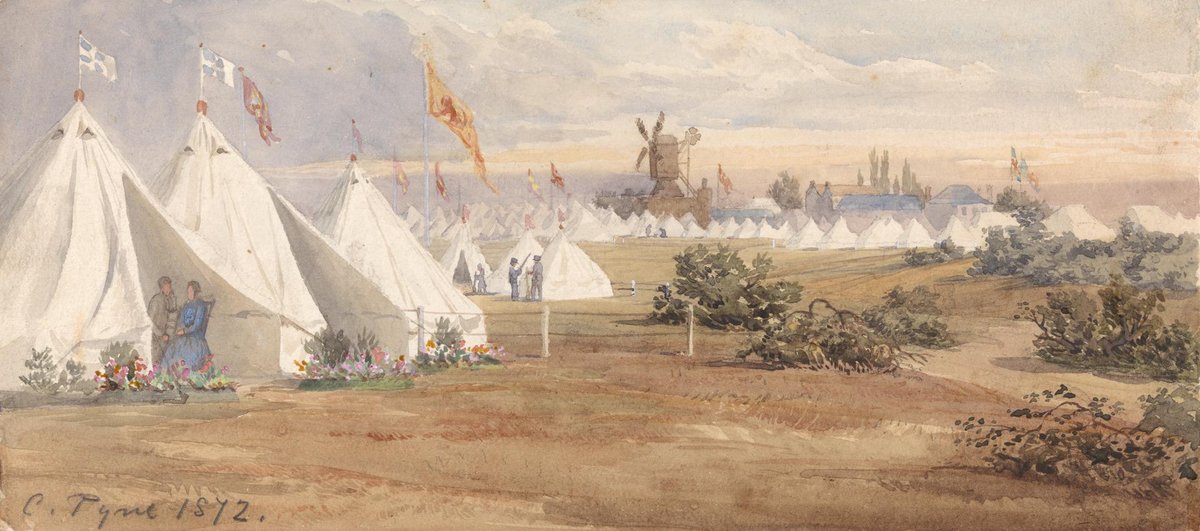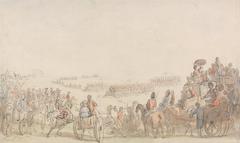
Wimbledon Common Visiting Guide – London, United Kingdom
Date: 14/06/2025
Introduction
Wimbledon Common is one of London’s most treasured and expansive green spaces, renowned for its rich history, ecological diversity, and recreational opportunities. Spanning over 1,140 acres in southwest London, it is managed together with Putney Heath and Putney Lower Common. The Common preserves a unique tradition of communal rights dating back to the medieval era, safeguarded through the Wimbledon and Putney Commons Act of 1871, which guarantees public access and conservation for generations to come (Wimbledon and Putney Commons Conservators; Londonist).
Visitors can enjoy a tapestry of ancient woodlands, heathland, wetlands, and diverse habitats supporting protected species like the stag beetle. The Common’s status as a Site of Special Scientific Interest (SSSI) and Special Area of Conservation underscores its ecological significance. Cultural landmarks abound, most notably the Grade II listed Wimbledon Windmill and its museum, reflecting local heritage (Graftingardeners; Guide London).
Open year-round with free entry, Wimbledon Common offers walking, cycling, horse riding, golfing, and a calendar of community events. Its accessibility via public transport, wheelchair-friendly paths near main facilities, and proximity to attractions like Wimbledon Village and Cannizaro Park make it a top destination for locals and visitors alike (WPCC; Condé Nast Traveller).
Table of Contents
- Introduction
- Historical Overview
- Conservation & Natural Heritage
- Notable Landmarks
- Visitor Information
- Activities & Events
- Family-Friendly Experiences
- Nearby Attractions
- Practical Tips for Visitors
- Frequently Asked Questions (FAQ)
- Conclusion
- References
Historical Overview
Medieval Origins and Communal Rights
Wimbledon Common’s origins trace back to the medieval period, when local villagers enjoyed customary rights for grazing livestock, collecting firewood, and small-scale farming—a system typical in southern England (Londonist). These “common rights” were not formally documented, but they shaped the landscape and community interactions for centuries.
19th-Century Preservation
The enclosure movement between the 16th and 19th centuries posed a significant threat as landowners pushed to privatize common land for economic gain. A pivotal moment came in 1871 with the Wimbledon and Putney Commons Act, following a successful local campaign led by Sir Henry Peek and others. The Act established the Wimbledon and Putney Commons Conservators, who continue to manage and protect the land for public use (Wimbledon Guardian).
Victorian Era and Urban Green Space
As London rapidly expanded, Victorians recognized the importance of urban green spaces for public health and recreation. The Common became known as one of the city’s “lungs,” a place for exercise and escape from industrial pollution. The General Enclosure Act of 1845 and subsequent local activism preserved Wimbledon Common as a vital public amenity (Londonist).
Conservation & Natural Heritage
Wimbledon Common is a designated SSSI and Special Area of Conservation, hosting a remarkable diversity of habitats—oak and beech woodlands, open heath, rare bogs, and multiple ponds (Guide London). It is especially important for invertebrate conservation, notably as a stronghold for the stag beetle (Lucanus cervus) (Graftingardeners; JNCC). Other wildlife includes kestrels, sparrowhawks, buzzards, tawny owls, foxes, bats, and ground-nesting birds such as skylarks.
Wetland habitats and ponds, such as Queensmere and Rushmere, support amphibians, fish, and waterfowl. Cattle grazing helps maintain the heathland’s biodiversity.
Notable Landmarks
Wimbledon Windmill & Museum
Built in 1817, the Grade II listed Wimbledon Windmill is a key historical site. It ceased operations as a mill in 1864, later becoming a residence and, since 1975, a museum. The Wimbledon Windmill Museum offers exhibits on milling, rural life, and the local area, with restored working mechanisms and interactive displays (Graftingardeners). The windmill is open weekends and bank holidays from late March to late October.
Visitor Information
Visiting Hours & Entry Fees
- Wimbledon Common: Open daily, dawn to dusk. No admission fee.
- Wimbledon Windmill Museum: Open weekends and bank holidays (late March–late October). Admission: £3 adults; free for children under 16.
Getting There & Accessibility
- Public Transport:
- Train/Tube: Wimbledon (District Line, Tramlink, National Rail), Putney (mainline), East Putney (District Line).
- Bus: 93, 57, 131 serve nearby stops.
- Tramlink: To Wimbledon station.
- Car: Windmill Car Park offers free parking (6:00 am–9:30 pm, 300 spaces). Other car parks: Telegraph and Springwell.
- Cycling/Walking: Dedicated paths throughout the Common.
- Accessibility: Wheelchair-accessible toilets at Windmill entrance (RADAR key required), accessible paths near main facilities, but much of the terrain is uneven and natural (Wimbledon Windmill).
Facilities & Safety
- Ranger’s Office: For information, emergencies, and event bookings (020 8788 7655).
- Toilets: Near Windmill and Ranger’s Office.
- Windmill Tearooms & Café: Hot drinks, snacks, and meals year-round.
- Dog Policy: Dogs welcome; keep on leads near livestock and wildlife, especially in nesting season.
Activities & Events
- Walking and Cycling: Well-marked trails through woodlands and heath.
- Horse Riding: Bridleways available; rides bookable at local stables.
- Golf: Wimbledon Common Golf Club and London Scottish Golf Club operate on the Common. Visitors welcome; dress code applies.
- Running: Wimbledon Common Parkrun every Saturday at 9am.
- Wildlife & Birdwatching: Rich habitats for stag beetles, birds, bats, and mammals.
- Picnicking: Ample open spaces; bring your own supplies.
- Photography: Best spots include Windmill, ponds, and heathlands at dawn/dusk.
- Guided Walks & Nature Talks: Regular events and educational walks (WPCC Events).
- Seasonal Events: Insect Day, Butterfly & Dragonfly walks, Bird Walks, Open Day, Healthy Walks, and more.
Family-Friendly Experiences
- Windmill Café: Popular for refreshments after walks.
- Children’s Activities: Interactive exhibits at Windmill Museum, open spaces for exploration.
- Farmers’ Market: Local produce and family-friendly atmosphere on Saturdays near Wimbledon Park Primary School (Candace Abroad).
Nearby Attractions
- Wimbledon Village: Historic streets, boutique shops, traditional pubs (Time & Leisure).
- Cannizaro Park: 35-acre landscaped gardens, rare trees, and floral displays (Condé Nast Traveller).
- Wimbledon Lawn Tennis Museum: Discover the history of the championships and tennis heritage.
Practical Tips for Visitors
- Footwear: Sturdy shoes for uneven/muddy terrain.
- Weather: Dress in layers; bring waterproofs if needed.
- Picnics: No formal picnic areas, but many scenic spots available.
- Respect Wildlife: Keep dogs under control; avoid disturbing grazing cattle or nesting birds.
- Litter: Use bins or take rubbish home.
- Emergencies: Ranger’s Office: 020 8788 7655.
Frequently Asked Questions (FAQ)
Q: What are Wimbledon Common’s opening hours?
A: Open daily, dawn until dusk. Windmill Museum open weekends and bank holidays (late March–late October).
Q: Is there a fee to visit Wimbledon Common?
A: No, entry is free. Small fee for Windmill Museum.
Q: Are dogs allowed?
A: Yes, but must be controlled near wildlife and livestock.
Q: Is the Common accessible for wheelchairs?
A: Wheelchair-accessible paths and toilets are available near main facilities; much of the terrain is natural.
Q: Are guided tours available?
A: Yes, at the Windmill Museum and through regular community walks and events.
Q: Where can I park?
A: Free parking at Windmill Car Park (6:00 am–9:30 pm); additional paid parking in Wimbledon town centre (Merton Council).
Conclusion
Wimbledon Common is an exceptional blend of natural beauty, historical legacy, and community spirit. Its protection since the 19th century has ensured that Londoners and visitors alike enjoy a rare expanse of wild heath, ancient woodland, and open space in the heart of the city. With a wealth of activities, free access, iconic landmarks, and an active calendar of community and conservation events, it stands as a model for urban green space preservation.
Whether you’re planning a peaceful stroll, a family day out, wildlife watching, or exploring local history at the Windmill Museum, Wimbledon Common welcomes all. For up-to-date information, event listings, and conservation news, visit the official Wimbledon and Putney Commons website and follow them on social media.
Enhance your visit: Download the Audiala app for audio guides, interactive maps, and real-time event updates. Explore our related articles for more on London’s best historic sites and outdoor adventures.
View Wimbledon Common Interactive Map
References
- This guide is based on information from the following sources:
- Wimbledon and Putney Commons Conservators
- Londonist – Why Does South London Have So Many Commons?
- Graftingardeners – The History of Wimbledon Common and Its Stag Beetles
- Guide London – Wimbledon Common Guide
- Wimbledon Guardian – Wimbledon Heritage: How the Commons Were Saved
- Condé Nast Traveller – Wimbledon Guide
- Wimbledon Windmill Museum
Related reading:




















































































































































































































































